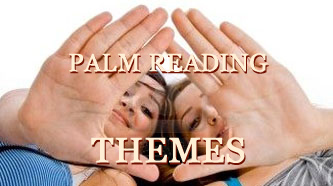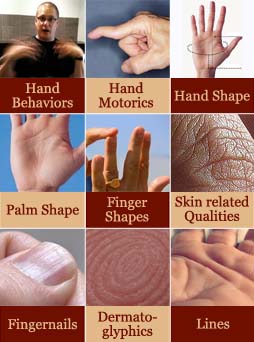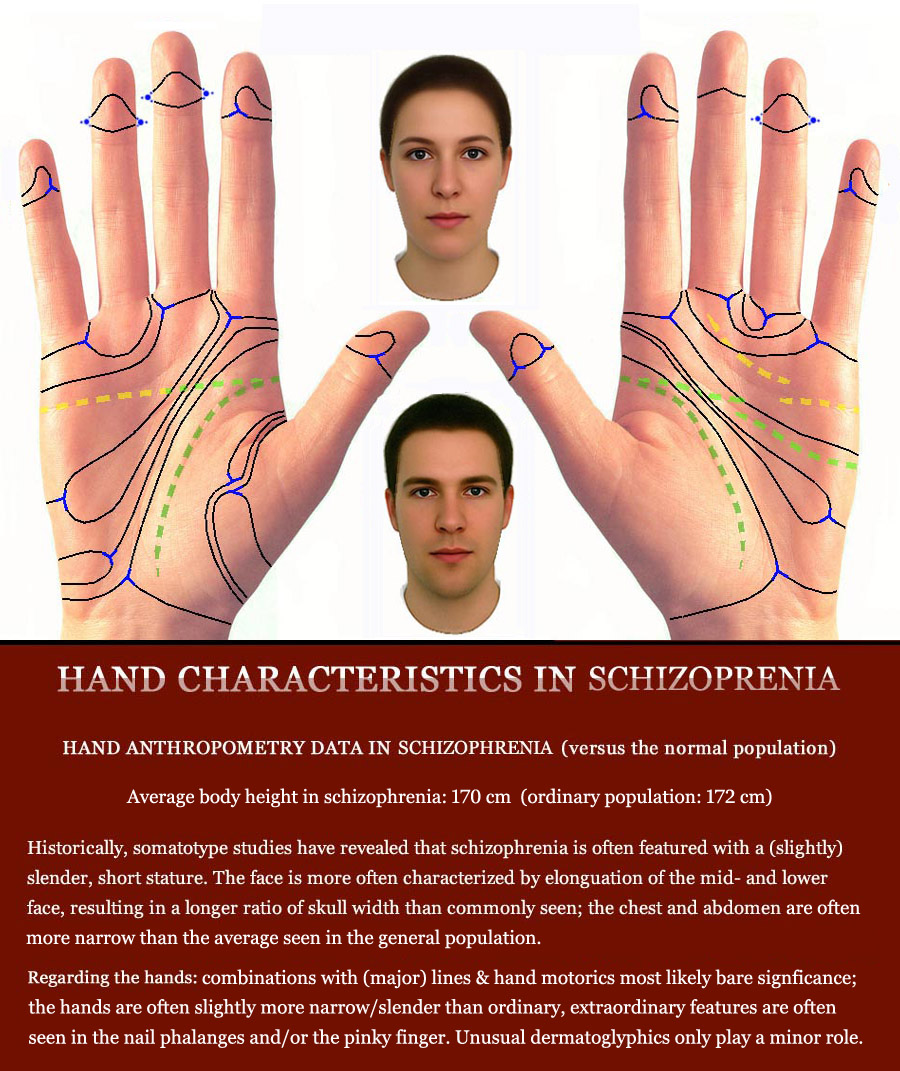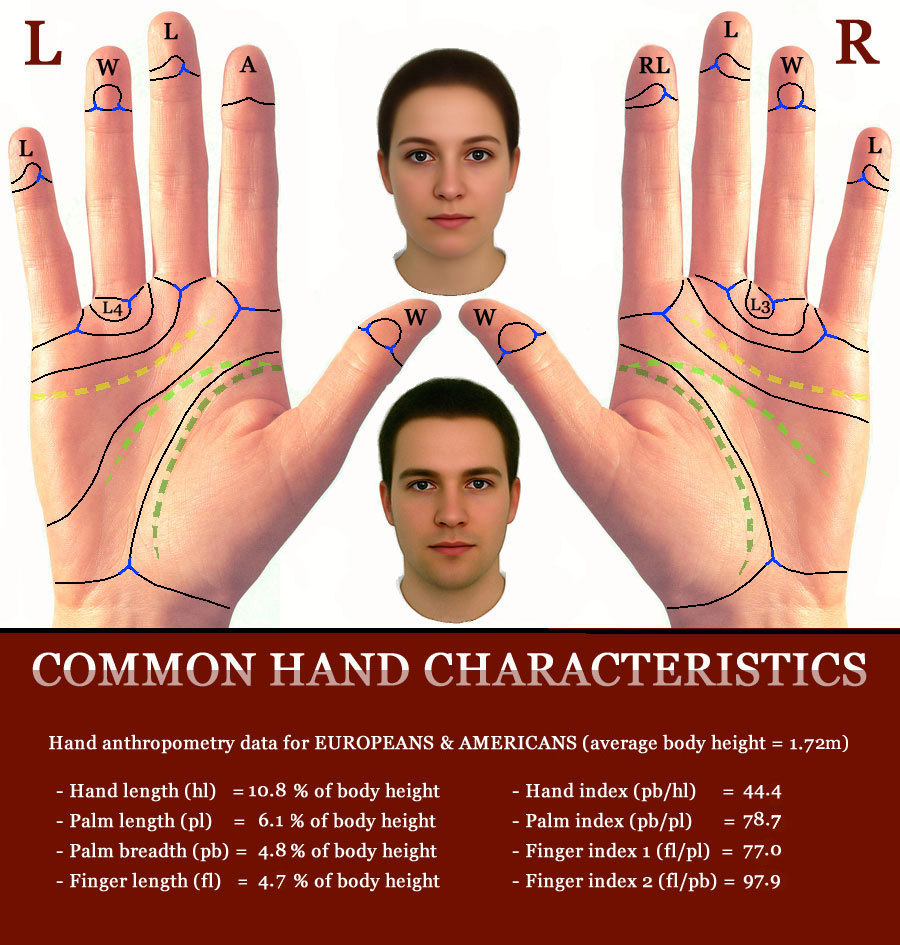|
|

Multi-Perspective Palm Reading themes:
SYNDROMES:
• Down syndrome & the hand system
• Fragile-X syndrome & the hand system
• Marfan syndrome & the hand system
DISEASES:
• Diabetes Mellitus & the hand system
• Psoriasis & the hand system
• Rheumatoid Arthritis & the hand system
PERSONALITY/BEHAVIOR RELATED FEATURES:
• Autism & the hand system
• Extraversion & the hand system
• Schizophrenia & the hand system
Discover more about hands:
• Hand Reading Research
• Hand Reading Forum
• Palm Reading Guide
• Hand Reflexology
Palm reading around the world:
• Chinese palm reading guide: Hong Kong (China)
• Palm reading: children lines & Karachi palmistry (Pakistan)
• Palm Reading: destiny lines & London palmistry (UK)
• Free psychic palm reading in New York (US)
• Indian palm reading: marriage lines & New Delhi palmistry (India)

The hand in schizoprehnia is an illustrative 'theme' which provides a deep reflection & awareness regarding how the structure of the hand correlates with the function of the hand.
Even though hands are recognized to represent the most differentiated part of the human body, this intimate connection is usually not highlighted in so-called 'philosophic systems' of hand reading (and hand reflexology).
• Reflexology Charts
|
|
Schizophrenia & the hand system
according Multi-Perspective Palm Reading!
Rule no.1 - Most significant major perspectives in schizophrenia:
Function - Proportion - Skin - Palm - Fingers [= 4 out of 5]
Rule no.2 - Most significant minor levels in schizophrenia:
(Major) Lines [level 9] & Hand Motorics [level 2]
Schizophrenia is a mental disorder characterized by abnormal social behavior and failure to recognize what is real (typically manifesting as: delusions, hallucinations and disorganized speech).
The hand system in schizophrenia varies in a subtile manner from the hand in ordinary people.
Often all 5 major perspectives get involved, but in some cases hand signs are found in no more than 4 of the major perspectives; the function & skin in both the finger(tip)s & (upper) palm typically are most likely to get involved.
For the hand in schizophrenia special attention is recommended regarding hand sign combinations which can be recognized to represent a combination of 'minor physical anomalies' and 'neurological soft signs'. Discover the details with Multi-Perspective Palm Reading!
The most significant minor LEVEL of the hand system in schizophrenia concerns the skin's (major) lines [level 9], closely followed by the functional aspect of the hand motorics [level 2]. However, more than half of the TOP 10 hand signs in schizophrenia (such as: 'lack of expression', 'excessive secondary creases', 'palmomental reflex', 'visible nail fold plexus', 'postural tremors' & 'chaotic arrangement of secondary crease') concern phenomena which vary in a subtile manner from the ordinary hand.
The hand proportions seen in people who have schizophrenia also tend to vary only in subtile manner from the ordinary hand, with a slight tendency towards 'feminine' features such as: dolichocheir (long & narrow hand shape) [level 3] & small thenar (mount of venus) [level 4], combined with tapering fingers, high 2d:4d digit ratio, extraordinary long index finger, extraordinary short pinky finger [level 5].
Some of the typical hand characteristics in schizophrenia are summarized in the advanced multi-perspective palm reading hand chart below.
Phantom picture for the hand in schizophrenia:

Specific parts of the hand - such as the fingertips and the pinky finger - may provide a deeper understanding regarding the hand system in schizophrenia; especially in those cases where multiple levels of the hand get involved:
In most schizophrenics one can expect to find at least one unusual hand sign at the finger tips; the following ten hand signs (involving 5 different levels of the hand) that can be described as 'uncommon' for the general population:
- impaired finger coordination [level 2];
- tapering/tapered fingers [level 5];
- small distal phalanages (microphalangia) [level 5];
- spatulate fingertips [level 5];
- pinky: curved inwards (clinodactyly) [level 5];
- visible nail fold plexus [level 7];
- nails: small & underdeveloped (rudimentary) [level 7];
- fingerprint type asymmetries (at least 3 out of 5 fingers) [level 8];
- extralimital triradii [level 8];
- excessive secondary creases [level 9].
In most schizophrenics one can expect to find at least one unusual hand sign at the pinky; the following 9 hand signs (involving 3 different levels of the hand) that can be described as 'uncommon' for the general population:
- pinky: immobility (ankylosis) [level 2];
- pinky finger: spatulate fingertips [level 5];
- pinky finger: small distal phalanages (microphalangia) [level 5];
- pinky: tapering/tapered fingers [level 5];
- pinky: curved inwards (clinodactyly) [level 5];
- pinky: extraordinary long [level 5];
- pinky: extraordinary short [level 5];
- pinky nail: excessively curved outwards (hyperconvex fingernails) [level 7];
- pinky nail: small & underdeveloped (rudimentary) [level 7].
TIP: Discover more about hands in syndrome, including the TOP 5 most significant hand signs in syndrome (selected from 47 significant hand signs):
47 Hand Signs in schizophrenia
Palm reading guide: common hand characteristics
providing a point of reference.

|
|